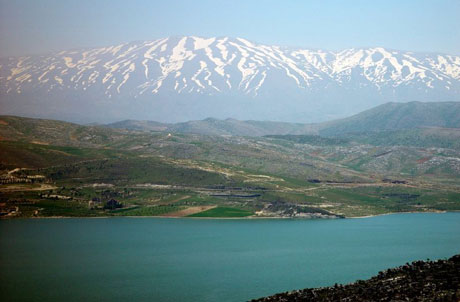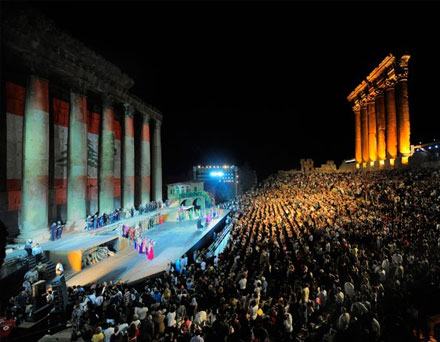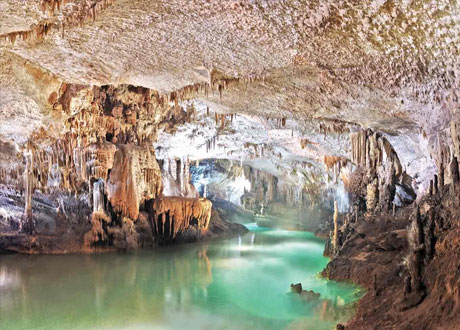Lebanon
Country statistics

Land area: 3,950 sq miles (10,230 sq km)
Total area: 4,015 sq miles (10,400 sq km)
Population (2010 est.): 4,125,247 (growth rate: 0.6%); birth rate: 15.1/1000; infant mortality rate: 16.4/1000; life expectancy: 74.8; density per sq km: 388
Capital City: Beirut
Monetary unit: Lebanese pound
Languages: Arabic (official), French, English, Armenian
Ethnicity/race: Arab 95%, Armenian 4%, other 1%
Religions: Islam 60% (Shi'a, Sunni, Druze, Isma'ilite, Alawite/Nusayri), Christian 39% (Maronite, Melkite, Syrian, Armenian, and Roman Catholic; Greek, Armenian, and Syrian Orthodox; Chaldean; Assyrian; Copt; Protestant), other 1%
Country introduction

Lebanon is part of the Middle East and is located in South-western Asia, bordering the Mediterranean Sea, between Israel and Syria.
Lebanon is fairly mountainous with a varied landscape that falls into four distinct features. First there is the narrow coastal plain where five of Lebanon's great historical cities developed: Tripoli, Byblos, Beirut, Sidon and Tyre. The 220 km (136 miles) long coastline is marked by indentations and rocky outcrops wherever the sub-coastal range joins the sea.
The second geographical feature is a north-south mountain range known as Mount Lebanon. The Lebanon Mountains, which are higher in the north than in the south, reach their maximum height and the maximum for the whole country, at the Qurnat as Sawda' 3,088 m (10,131 ft). Appearing at times to rise abruptly from the sea, Mount Lebanon covers more than a third of the country. Its western slopes are well wooded and are frequently broken by wild valleys. The mountain rise gradually over a distance of some 30 km (18 miles) to the highest peaks of Sannine 2,628 m (8,622 ft) and Qornet es Sawda 3,069 m (10,068 ft). It is Mount Lebanon, or Jabel Lubnan in Arabic, that gave the name to the country. In fact Lebanon owes its geographical unity to this mountainous range which is almost entirely contained within its frontiers.
The next of Lebanon's four areas is the Beqaa valley between 8 to 15 km (4 to 9 miles) wide and about 120 km (74 miles) long from north to south. A fertile plain east of the Mount Lebanon range between 800 and 1,250 m (2,624 and 4,101 ft) in elevation, the Beqaa valley was known as the breadbasket of the Roman Empire in ancient times. Still the major agricultural zone of Lebanon, the central area, is the most fertile while the southern past is less cultivated, being swampy and full of rocks. It is through the Beqaa that the 140 km (86 miles) long Litani River, the longest in the Lebanon, turns to meet the Mediterranean between Sidon and Tyre.
On the eastern side of the Beqaa rise the Anti-Lebanon mountains and Mount Hermon to 2,814 m (9,232 ft). These are a chain of rocky, almost treeless mountains running parallel to the Lebanon range. Both ranges are mostly Mesozoic limestone from the Jurassic and Cretaceous because they formed a single system that was split in two when the Great Rift Valley was formed. The sunken part is the Beqaa valley, at altitudes between 800 and 1,200 m (3,937 km).The Anti-Lebanon is lower but more complete than Mount Lebanon. These mountains form the frontier between Lebanon and Syria.
The culture

The area including modern Lebanon has been home to various civilizations and cultures for thousands of years. Originally home to the Phoenicians, and then subsequently conquered and occupied by the Assyrians, the Persians, the Greeks, the Romans, the Arabs, the Crusaders, the Ottoman Turks and most recently the French, Lebanese culture has over the millennia evolved by borrowing from all of these groups. Today, Lebanese society is very modern and similar to certain cultures of Mediterranean Europe. It is often considered as Europe's gateway to Western Asia as well as Asia's gateway to the Western World.
Lebanon's diverse population, composed of different ethnic and religious groups, has further contributed to the country's culture. The way of life in Lebanon is strongly divided between Muslims and Christians. This divide also alters how each individual identifies and dictates numerous other rules involving dress, behavior, and diet. In the 300s many of the people of the region, known as the Canaanites or Phoenicians converted to Christianity and today a substantial percentage of the population still practices this religion. The Christians tend to be more liberal than the Muslims in many realms so dress more freely, drink alcohol, and have few restrictions on dating or communication between the sexes. In the 600s Islam arrived and today most of the people in Lebanon are Muslim. This faith is more conservative than Christianity on most measures and the faithful are required to dress conservatively, abstain from alcohol, and they also have other regulations, including stricter guidelines on dating and interacting with people of the opposite sex. Although the country found itself in civil war in 1975 and tensions still exist between the Christians and Muslims, for the most part, the people have learned to accept differences and work together.
Among all the festivals of Lebanon the most important are the Baalbeck International Festival, the Beiteddine Festival, the Byblos International Festival and Tyre Festival. The Baalbeck International Festival is the oldest and most prestigious event in the Middle East, which takes place in the Roman Acropolis during the two months of July and August each year. The Beiteddine Festival held in a 200 year old palace in Beiteddine, a little town in the mountainous region of the Chouf, 45 km (27 miles) south-east of Beirut, occurs during the festive season of summer.
At one time, international opera, ballet, symphony and drama companies worldwide performed in Beirut. Some Lebanese artists are active in European opera and theater companies, while others are trying to create a wider audience for classical Arabic music and theater. Dabkah (the national dance) and zajal (folk poetry) are enjoying a revival.
Lebanese cuisine includes an abundance of starches, whole grain, fruits, vegetables, fresh fish and seafood; animal fats are consumed sparingly. Poultry is eaten more often than red meat. When red meat is eaten it is usually lamb on the coast, and goat meat in the mountain regions. It also includes copious amounts of garlic and olive oil, often seasoned by lemon juice. Olive oil, herbs, garlic and lemon are typical flavours found in the Lebanese diet.
Attractions & landmarks

Lebanon, an ancient country bordering the eastern Mediterranean Sea, has many interesting historic landmarks. This nation's long history has left ancient ruins scattered across the countryside. These landmarks are notable for both their historical and religious aspects. The country also draws tourists for its natural features.
The ruined temples of the city of Baalbek provide the modern world with a glimpse into Lebanon's Roman and Phoenician past. Dilapidated temples dedicated to Jupiter, Venus and Bacchus remain. The foundation stones of the temple of Jupiter are notable and mysterious; they weigh somewhere between 1 and 2 million lbs. Contemporary scholars still do not know how the architects and engineers laid these stones in place nearly 2,000 years ago.
Visible from the coastal area of Beirut, the Pigeon rocks remind both tourists and residents of Beirut that Lebanon is marked by natural beauty as well as ancient architectural monuments. These two rocky buttes jut vertically from the water just off shore. The beach near the Pigeon Rocks has revealed evidence of ancient human habitations in Beirut.
The Jeita Grotto, a popular tourist attraction, was not discovered until 1836. Visitors can reach the lower caves only by boat. A concrete tunnel more than 97 m (320 ft) long accesses the upper caves. Both the upper and lower caves feature wonders of natural creation in stone, crystals and hidden pools. During the winter these caves are closed to tourists due to high water levels.
The varied terrain, scenic vistas, and a historic environment combine to create unique hiking and trekking opportunity throughout Lebanon. Popular areas for hikes include the Horsh Ehden Nature Reserve near Tripoli, and the Al-Shouf Cedar Reserve, both of which offer good and extensive trail systems. Other areas with spectacular scenery and unique historical and cultural attractions include the Qadisha Valley, Makmel Park, and the remote Aakkar region in the north. For a quintessential Lebanese experience, visitors can wander through the Adonis Valley, a ruggedly cut gorge sprinkled with historic ruins that is the site of Adonis and Aphrodite's love story in Greek mythology. There are many trekking clubs and tour operators that run guided outings throughout Lebanon, ranging from leisurely day hikes to longer multi-day treks.